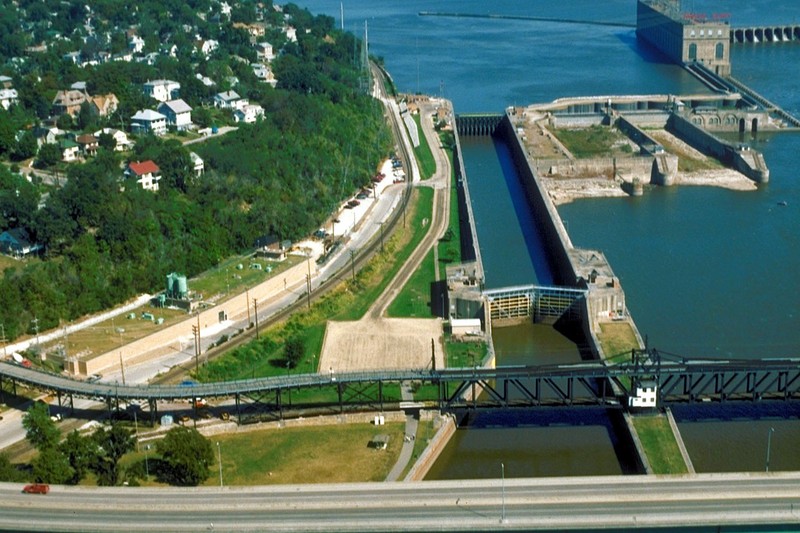Lock and Dam No. 19
Introduction
Text-to-speech Audio
Known today as the Keokuk Energy Center, Lock and Dam No. 19 is the largest privately owned and operated dam and hydroelectric power plant on the Mississippi River. It was built in 1913 and the current lock was constructed in 1957. The lock is 1,200-feet long and 100-feet wide, and the dam itself is nearly a mile long at 4,620 feet. The original lock and dry dock, which are next to the 1957 lock, are no longer used. The powerhouse was built in 1913 and contains 15 generators that produce 60Hz of alternating current. The entire site comprises the Lock and Dam No. 19 Historic District, which is listed on the National Register of Historic Places. Ameren Missouri, which is a subsidiary of the Ameren Corporation, owns and operates the facility. Visitors can view the lock and dam from a public platform that overlooks the site.
Images
Lock and Dam 19 was built in 1913 and is the largest privately owned and operated dam and hydroelectric power plant on the Mississippi River. In this photo, the 1957 lock is on the left and the old dry dock, old lock, and powerhouse are on the right.

Backstory and Context
Text-to-speech Audio
In 1837, Lieutenant Robert E. Lee (the future Confederate general of the Civil War) and Second Lieutenant Montgomery Meigs in 1837 surveyed this part of the river, which had a 23-foot drop in 12 miles, and believed it could be used in some way. Nothing came of their survey, however. In 1848, a group of Keokuk leaders formed a company to build a dam and locks to facilitate better navigation (the rapids essentially blocked most vessels from sailing upstream) and supply power to mills in Keokuk. The inability to find financing for the project, the weak national economy of the 1850s, and the Civil War prevented the project from moving forward. The plan was not revised after the war but in 1868 the federal government built a nine-mile canal to bypass the rapids.
By the late 1800s, electricity was beginning to be harnessed on a large scale. A group of Keokuk businessmen revived the idea of building a dam and established the Hamilton Water Company. In 1905, President Theodore Roosevelt signed a bill approving the project. The company had difficulty obtaining financial backing during the next few years but construction finally began in 1910 and was completed in 1913.
The lock and dam achieved a number of milestones in the history of hydroelectric power in the U.S. These include: the longest monolith concrete dam, the largest turbines, the largest inland dry dock, the heaviest rotating weight suspended on a single bearing, the first long-distance transmission line, and the first high-voltage transformers and insulators. It was also the country's largest privately funded hydroelectric project. The high-voltage transformers, insulators, and transmission towers are particularly notable. Their design served as the basis for the development of modern-day, high-voltage transmission technology. Some of the generators were converted from 25 Hz to 60 Hz in the 1940s and 1950s and the rest were converted in 2002.
Sources
"Lock 19." U.S. Army Corps of Engineers. Last Updated August 2018. https://usace.contentdm.oclc.org/utils/getfile/collection/p16021coll11/id/2962.
Martin, Kent. "Keokuk Energy Center: Harnessing the Power of the Mississippi." Hydro Review. November 7, 2013. https://www.hydroreview.com/world-regions/keokuk-energy-center-harnessing-the-power-of-the-mississippi.
Rathbun, Mary Yeater. "Lock and Dam No. 19 Historic District." National Park Service - National Register of Historic Places Nomination Form. March 10, 2004. https://npgallery.nps.gov/GetAsset/5a8fcdd3-c1c6-4325-a66b-a0dc5441acf0.
Rathbun, Mary Yeater. "Upper Mississippi River Nine-Foot Channel Project, Lock and Dam Complex Number 19." National Park Service - Historic American Engineering Record Form. August 1988. https://tile.loc.gov/storage-services/master/pnp/habshaer/ia/ia0100/ia0185/data/ia0185data.pdf.
Wikimedia Commons: https://commons.wikimedia.org/wiki/File:Mississippi_River_Lock_and_Dam_number_19.jpg
